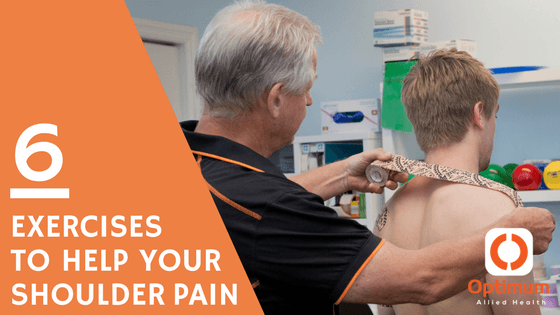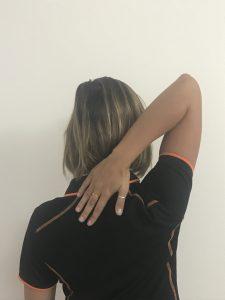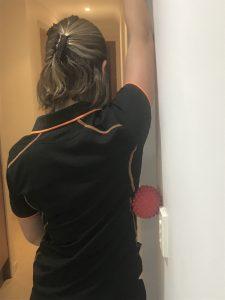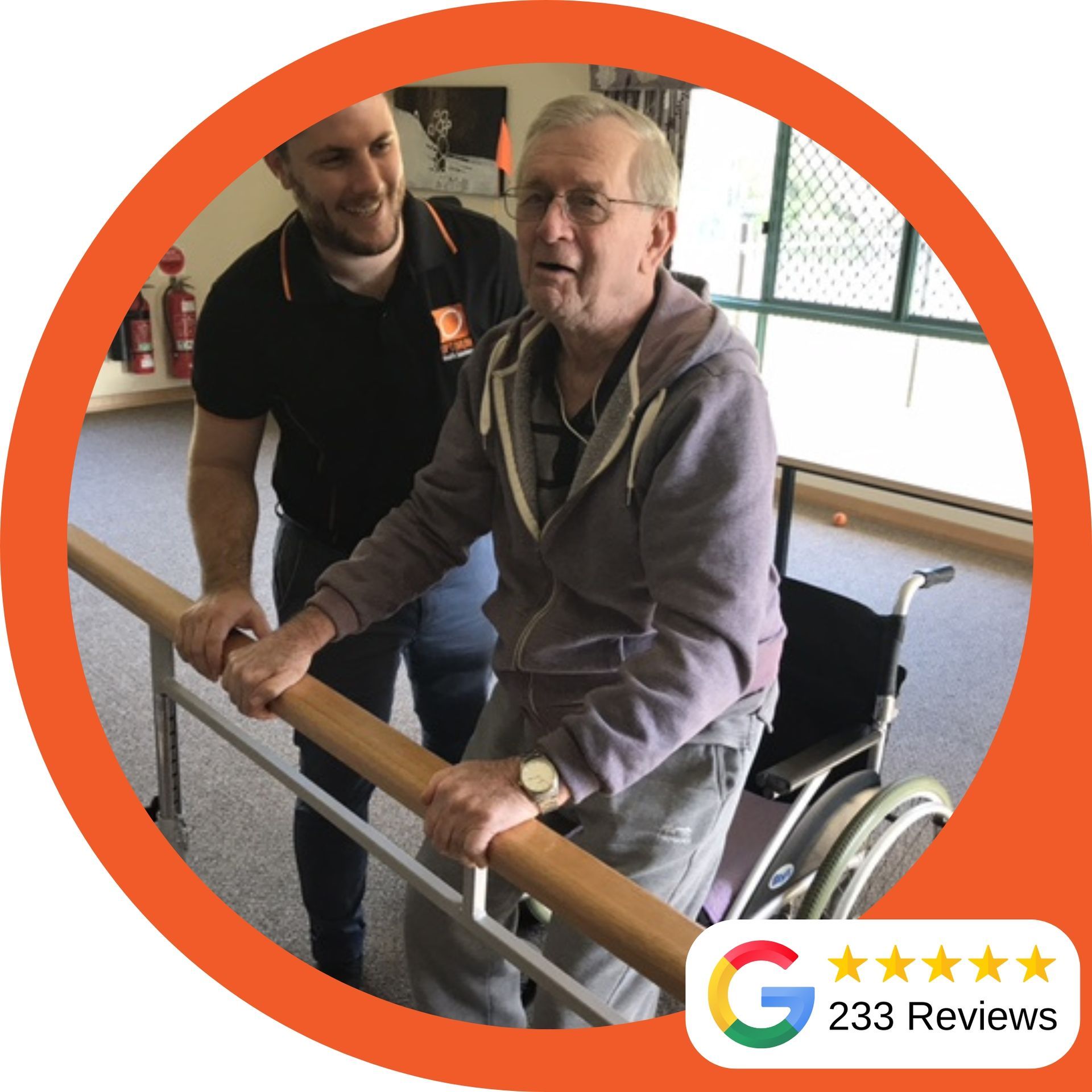Let’s talk about your shoulder pain… and how to fix it! | Optimum Allied Health
Let’s talk about your shoulder pain… and how to fix it! | Optimum Allied Health
We live in a society where poor posture is part of our lives. We sit all day, we drive for too long and spend our time looking down at our phones or computers.
No wonder we get sore necks and shoulders!
Poor posture can cause us to become round shouldered (technical term: protracted shoulder girdle), which can cause muscular imbalances between the chest and upper back muscles. Over time this posture will cause issues with the upper back, shoulders and neck and eventually… can affect your lower back.
Everything in our body is linked. If one area doesn’t function it will flow onto other areas.
The shoulder is one of the largest and most complex joints in the body. It is formed where the humerus (upper arm bone) fits into the scapula (shoulder blade), like a ball and socket. There are supporting muscles, ligaments and tendons whose job is making the shoulder move in the correct motion. These muscles are also very important for our posture.
How mobile good is your shoulder mobility?
Give this quick shoulder mobility check a go with these three simple steps.
Were you able to complete all three without restriction, pain or jerky movement?
Our shoulder’s stable base is the scapula (commonly called “shoulder blade”) and it is essential that it is strong and stabilized in order for our shoulder joint to move properly. This is also supported by a healthy strong upper back and good posture.
Appropriate scapula movement is termed scapulohumeral rhythm and it should be smooth, co-ordinated and symmetrical. Problems arise when this rhythm is disturbed and it becomes altered, jerky, restricted and/or painful. When these problems arise it can cause movement adaptation, joint restriction due to subconscious protection, motor control problems with the scapular stabilisers and weakness in the rotator cuff muscles.
All in all – that equals pain and stiffness.
Give these exercises a try to help keep your shoulders and upper back strong and functional. Injury prevention and joint health is the goal.
Try these 3 release exercises:
1. Trigger ball upper trap
- Place the ball on the upper trap muscle which is halfway between your shoulder and neck.
- Then bend your knees and bend forward leaning into a wall.
- Let your hand hang where it is comfortable.
- Slowly roll over the muscle and search for tender muscle tissue.
- Massage each painful spot with a couple of rolling motions.TIP: You can place you arm like the picture below shows for an even deeper release. Please consult an expert if you have neck problems before trying this exercise.
You can use a tennis ball, hockey ball, whatever works for you.
ButtonWhy is this important?
So much tension is held in the upper trapezius which can lead to neck pain, headaches and the scapula being out of position (to0 high). The shoulders may be elevated long term and this is not healthy for the joint space in the shoulder. Elevated traps also make it difficult to fire the middle and lower traps which eventuates in losing our ability to properly stabilize the shoulder. The Upper trap then takes over and the vicious cycle continues.
2. Trigger ball release Teres Major/Lats•
- Place the ball on the muscle and on the outer edge/border of your shoulder blade, respectively.
- Then bend your knees and lean against a wall .• Slowly roll over the muscle and search for tender muscle tissue.
- Massage each painful spot with a couple of rolling motions.
TIP:
You can also try lifting your arm up and down and rotating forward and back to get different angles of the muscles.
Why is this important?
When the little muscles under the shoulder (teres major/minor) and those that surround the inferior (bottom) angle of our scapula (latisimus dorsi) get too tight it prevents the scapula from moving in its normal sliding motion and upward rotation. We need to first release the muscles then retrain them how to move properly (called muscular patterning).
3. Chest myofascial release
- Place the ball on your chest and lean against a wall.
- Roll over the muscle and massage each tender spot with slow strokes.
- You can lift your arm out to the side to get deeper into the muscle
Why is this important?
The pec major and minor which are targeted in this release can become tight which contributes to forward head posture, forward rotated shoulders and eventually poor shoulder health and pain. To get the shoulders to sit back into normal position this area needs to be released!
Now that we’ve stretched.. it’s time to strengthen
Try these 3 upper back postural and rotator cuff strengthening exercises
1. Theraband Shoulder External rotations
- Begin with band looped around your hands, with a length of band between your hands about a shoulder-width apart.
- Squeeze your shoulder blades together, gently stretching the band between your hands. Hold and slowly return.
TIP:
Keep your back and neck straight. Don’t extend your elbows during the exercise; keep them bent at your side.
Why is this important?
This exercise targets your rotator cuff health which is integral to shoulder health. This group of 4 muscles allows the scapula to perform its main movements including: elevation, depression, protraction, retraction, upward rotation and down ward rotation. They also allow the shoulder to function painfree.
2. Theraband pull aparts
- Set up with a resistance band in front of you, wrists as straight as possible, shoulder blades and rib cage down.
- Draw the resistance band towards outwards from your body and maintain a neutral posture throughout the exercise
- Use your upper back muscles to perform the exercise allowing your shoulder blades to move freely.
Why is this important?
Scapula retraction promotes strengthening between the lower and middle portions of the rhomboids and middle traps. For the shoulders to stay in appropriate positioning throughout your whole day the muscles that control the middle portion of the back and shoulders must be strong and durable.
3. Serratus Anterior roller activation
- Use a light resistance band and wrap it around your forearms so your inner arms/ palms face each other
- Place a foam roller between your wrists and the wall and gently lean into the foam roller
- Raise your arms upwards and the roller will work its way down toward your elbows. Then roll downward so the roller makes its way back up to your wrists.
- While this is happening, press your forearms outward against the band.Fun
TIP:
this is probably my favorite exercise for promoting shoulder health and it is not easy if done correctly.
Why is this important?
This little muscle we are targeting allows the forward rotation of the arm and pulls the scapula forward around the rib cage. It allows the scapula to move laterally which is intergral for elevation and upward rotation of the arm. Without this muscle functioning properly your shoulder will be very unsteady lifting overhead items. The isometric tension provided by the band prevents altered/poor movement and allows the rotator cuff musculature to be engaged through the entire movement like it should be with overhead lifting.
4. Theraband/cable row
- Secure the band in front of chest, sit down and grab both handles, arms extended and palms facing each other.
- Pull the handles back towards your abdomen and allow them to slowly return after a short pause.
- Keep your back straight and still throughout.
TIP:
Make sure you squeeze your shoulder blades down and back into their ‘pockets’. DO NOT raise your shoulders to your ears.
Why is this important?
Like the pull aparts this involves scapula retraction and is essential for good posture. The exercise engages both the middle and lower portions of the back muscles promoting healthy shoulder and posture.
If you suffer shoulder pain, upper/mid back pain or shoulder pain please seek advice from an Exercise Physiologist or Physiotherapist. Or alternatively for a posture and shoulder mobility check come in and see us in and we can give you a program to keep your shoulder joints healthy, upper back strong and posture good.
If you need help getting the equipment needed for these exercises – drop by one of our clinics
and we’ll be happy to help!
Chantal Burness, AEP, ESSAM
Chantal is an Accredited Exericse Physiologist (AEP) and is passionate about using exercise to treat chronic disease and injuries. She graduated in 2012 and has both undergraduate and postgraduate qualifications in her area. Chantal leads our Lismore and Ballina exercise physiology teams and previously sheworked for the past 5 years consulting as an EP in private practice on the Gold Coast and prior to this she worked for a group of cardiologists as a Cardiac Technician performing non-invasive investigations.























